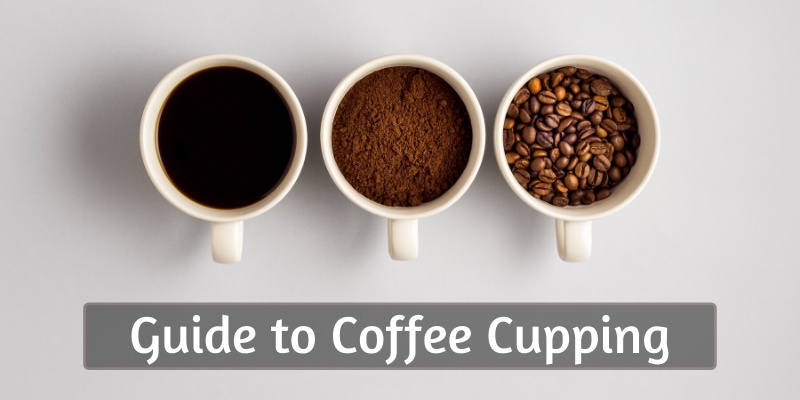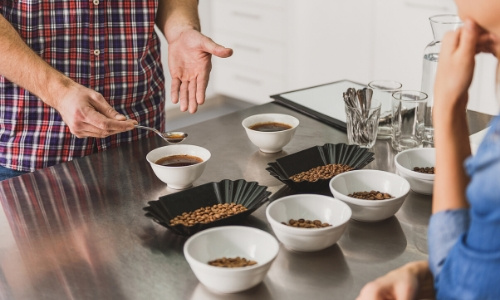Ever heard of coffee cupping ? If you're reading this, you probably have and you're curious to know more. Here's a little explainer for you.
In the world of coffee two cooks define this singular product called coffee: The Roaster and The Professional Barista.
With fire, the Roaster modifies the dry coffee beans into something completely different.
With his knowledge and experience, the Barista "cooks" the roasted beans, extracting the aromas and creating a beverage.
But who defines the value of what the chef is offering? The final customer, of course.
Even before the customer, there is a Taster. This one has a lot of experience and specific education in understanding the taste and sensations.
This is going to be our subject today. What makes a Taster so different? How can his knowledge help us understand the world of tasting coffee? Let's see.
First of all, anyone can become a good taster. Secondly, the perfect tool to improve our map of tasting coffee is something called cupping. I'm sure a lot of people heard about wine tasting or tea tasting, but today we are going to talk about coffee tasting.
Table of Contents
What is coffee cupping?
Cupping is a separate activity practiced all over the world to evaluate the quality of the coffee beans. Similar to wine tasting, cupping is all about evaluating the coffee from different perspectives: visual analysis, smell, tactile sensations, and taste.
Also, this method of evaluating coffee requires some tools like several sampling roasters, a grinder, special cups, cuspidors, an electric kettle, glasses of water, deep tasting spoons, sometimes even a colorimeter to determine the level of roasting.
in short, cupping is a way to truly understand a specific coffee. You end up thoroughly feeling and understanding that coffee from bean to brewed cup.
As a barista or avid coffee fan, this is a noteworthy experience and it can be something to talk about at length.
How does cupping help you?
Tasting coffee better, or tasting anything better, can help all of us understand what we consume every day.
In general, this method of evaluating coffee called cupping is made by roasters to determine the quality of beans, and by coffee shop owners to pick one of the best beans. And, of course, by the barista to experience coffee better and to improve its taste.
For you it can be a unique way to understand your knowledge about tasting and coffee. Also, it is a perfect way to pick your beloved beans.
But first of all, let's see what is the protocol for cupping, and after that, how to improve our taste by actually tasting.
So how do you cup coffee ?
As I said before, it requires some tools. It is not mandatory to have all the them. That's why I will keep it simple, so I'll give you only the most basic tools you'll need.
Quick tip: you'll need at least 3 different coffees to make a cupping evaluation, or the same coffee roasted in at least 3 different ways.
Equipment for cupping:
- Cupping glasses or cups. It is recommended that cupping vessels to be glass or ceramic. They should be between 207- 266 ml/ 7-9 oz with a matching lid.
- Ground coffee. This should be slightly coarser than typically used for paper filter drip brewing. All the coffee you use should be ground in the same size.
- Water at 93 C/200 F. Use a clean and odor-free water, but not distilled or softened. The ideal TDS (Total Dissolved Solids) are 125-175 ppm, but should not be less than 100 ppm or more than 250 ppm.
- Timer. It's very important to not brew the grounds for more than 5 minutes.
- Spoons. Some deep spoons are enough.
- Glasses for warm water. This is really important. After each sip it is necessary to clean the spoon before the next sip.
- Glasses for the crust. After the coffee is brewed in the cup, a crust will appear on top. You need to get through that crust, smell at the same time (this will be the first impact with coffee), and clean the surface of the coffee to avoid drinking ground coffee. All that crust will end in these glasses.
- Lids. Every cup needs a lid. You can use a little plate.
Preparation of cupping
On your favorite table, put the cups with ground coffee in a row. Don't forget to place a note in front of every cup describing what coffee you use to better understand what you taste.
Then place the glasses with hot water for cleansing and the glasses for the crust. Prepare the spoons and the timer.
Into the cupping cups add your ground coffee. Pour the water carefully in, and set the timer to 4 minutes of brewing. Place the lid on each cup.
After 4 minutes, break the crust and smell the top of the coffee. Try to memorize that smell for judging the coffee. Every time you notice something, write it down.
Clean the crust and place all of it into a dedicated glass. Now you can start with the fun part, the tasting. Good manners are not important here.
Get a clean spoon. Get a spoonful and taste it. In order to get the best experience you'll need to sort of suck in some air into your mouth, over your tongue, while the coffee is on your tongue. You're sort of picking up the notes from the coffee.
It's loud, yes, but it's the best way to figure out notes.
To get a really thorough analysis you should taste the coffee at its peak (about 5 minutes) but also at 10 and 15 minutes, to see how it breaks apart and the way the notes change.
Be sure to take notes from each cup and rinse your mouth with cold fresh water between each cup, to keep your palate clean.
How to taste coffee notes
There are some criteria for evaluating coffee. I'll show you some of this.
First of all, the variety and the processing method are key: there is a big difference in taste between washed and natural processed coffee.
Now let's see some of the main criteria and the right way to describe them.
- Taste. It is used to asset the basic flavor which can be noticed by the tongue. It can be defined as sweet, salty, harsh, nutty, buttery, spicy, woody, fruity, winey, astringent, honey, malty, velvety, and so on.
- Body. It is judged based on the tactile feeling in the mouth. It can be described as a weak body, watery, rich, full-body, and so on.
- Acidity is meant to describe the impact the fruit acids give during tasting. They are characteristic of liveliness and versatility. It can be sour, fruity, citric, and so on.
- Flavor evaluates the spectrum of aromas and their rhythmical interplay. This is done using the nose, which is why the coffee is sniffed and spread throughout the mouth during cupping. It can be described as mild, strong, floral, rotten, roasty, smooth, creamy, sharp, ashy, smokey, medicinal, tobacco-like, fresh lively, and so on.
- Aftertaste gives information on how long the coffee flavor stays in the mouth and whether the aftertaste is a pleasant one.
- Balance defines the interplay between all the criteria.
This criteria of evaluating is used during the cupping to describe each sip of coffee. Now let's see what are you looking for in a cup.
Most common notes to look for
Everyone can conclude which is good and which is not satisfying. But what are we looking for in a cup of coffee? Of course, the fresh taste and aromas.
Main notes and the common found in a cup: sweet, nutty, chocolate, fruity, full-body, fresh smooth, and all the good stuff. Every cup of coffee should be good overall.
Yet, mistakes happen. This is why cupping is made in the first place. To ensure that the coffee doesn't have bad taste and notes.
Notes you should avoid
There is a coffee nosing wheel developed by the SCAA that gives you the right view of notes.
For example, if we talk about sour taste, there are different ways of sour as winey sour or hard sour or tangy sour. Winey sour can be a good sign in a coffee cup, while tangy sour not.
Another good example is the sweet taste. There are several ways of seeing this one. It can be mellow sweet, nippy sweet, sugar-sweet, and so on. Of course, nippy sweet is not a good sign in a cup, while sugar-sweet is.
In terms of aromas (these can be perceived by the nose) there are many ways to determine a cup of coffee. It can be enzymatic, including notes like flowery, fruity, herby aromas, or dry distillation including notes like spicy, resinous, carbon.
Of course, if a cup of coffee smells like flowers, it is a good sign while smelling like char is not.
In conclusion, when someone is doing a coffee cupping, the good coffee will be easy to find. Notes like pepper, tarty, pipe tobacco, spicy should be avoided.
At the same time, notes like vanilla, walnuts, apricot, tea rose, coffee blossom should be a good sign. Only good coffee can deliver notes like this.
I hope this guide was helpful to you and you can taste coffee on your own now, in the comfort of your own home. Even if it's an experience that's not as thorough as a certified class could give you, you now know the basics.
If you want to know more about coffee or tea, feel free to check the related articles below. Who knows what else you might find ?








